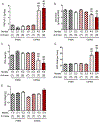β-endorphin at the intersection of pain and cancer progression: Preclinical evidence
- PMID: 33387660
- PMCID: PMC7837276
- DOI: 10.1016/j.neulet.2020.135601
β-endorphin at the intersection of pain and cancer progression: Preclinical evidence
Abstract
We examined the association between endogenous opioid β-endorphin, cancer progression and pain in a transgenic mouse model of breast cancer, with a rat C3(1) simian virus 40 large tumor antigen fusion gene (C3TAg). C3TAg mice develop ductal epithelial atypia at 8 weeks, progression to intra-epithelial neoplasia at 12 weeks, and invasive carcinoma with palpable tumors at 16 weeks. Consistent with invasive carcinoma at 4 months of age, C3TAg mice demonstrate a significant increase in hyperalgesia compared to younger C3TAg or control FVBN mice without tumors. Our data show that the growing tumor contributes to circulating β-endorphin. As an endogenous ligand of mu opioid receptor, β-endorphin has analgesic activity. Paradoxically, we observed an increase in pain in transgenic breast cancer mice with significantly high circulating and tumor-associated β-endorphin. Increased circulating β-endorphin correlates with increasing tumor burden. β-endorphin induced the activation of mitogenic and survival-promoting signaling pathways, MAPK/ERK 1/2, STAT3 and Akt, observed by us in human MDA-MB-231 cells suggesting a role for β-endorphin in breast cancer progression and associated pain.
Keywords: Breast cancer; Morphine; Opioid; Pain; β-Endorphin.
Copyright © 2020 Elsevier B.V. All rights reserved.
Figures




Similar articles
-
Cannabinoid Receptor-2 Activation in Keratinocytes Contributes to Elevated Peripheral β-Endorphin Levels in Patients With Obstructive Jaundice.Anesth Analg. 2021 Jul 1;133(1):251-262. doi: 10.1213/ANE.0000000000005405. Anesth Analg. 2021. PMID: 33560661
-
Implication of endogenous beta-endorphin in the inhibition of the morphine-induced rewarding effect by the direct activation of spinal protein kinase C in mice.Neurosci Lett. 2008 Mar 5;433(1):54-8. doi: 10.1016/j.neulet.2007.12.042. Epub 2008 Feb 8. Neurosci Lett. 2008. PMID: 18262361
-
The rewarding action of acute cocaine is reduced in β-endorphin deficient but not in μ opioid receptor knockout mice.Eur J Pharmacol. 2012 Jul 5;686(1-3):50-4. doi: 10.1016/j.ejphar.2012.04.040. Epub 2012 May 2. Eur J Pharmacol. 2012. PMID: 22575525 Free PMC article.
-
[Difference in tolerance to anti-hyperalgesic effect and its molecular mechanisms between chronic treatment with morphine, fentanyl and oxycodone in a chronic pain-like state].Nihon Shinkei Seishin Yakurigaku Zasshi. 2008 Nov;28(5-6):169-76. Nihon Shinkei Seishin Yakurigaku Zasshi. 2008. PMID: 19108502 Review. Japanese.
-
Regulation of cancer progression by β-endorphin neuron.Cancer Res. 2012 Feb 15;72(4):836-40. doi: 10.1158/0008-5472.CAN-11-3292. Epub 2012 Jan 27. Cancer Res. 2012. PMID: 22287549 Free PMC article. Review.
Cited by
-
Neuroendocrine Factors in Melanoma Pathogenesis.Cancers (Basel). 2021 May 10;13(9):2277. doi: 10.3390/cancers13092277. Cancers (Basel). 2021. PMID: 34068618 Free PMC article. Review.
-
The role of long noncoding ribonucleic acids in the central nervous system injury.Mol Cell Biochem. 2024 Oct;479(10):2581-2595. doi: 10.1007/s11010-023-04875-0. Epub 2023 Oct 28. Mol Cell Biochem. 2024. PMID: 37898578 Review.
-
Comprehensive analysis of pain genes in prognosis of kidney renal clear cell carcinoma and tumor immunotherapy: A comprehensive bioinformatic study.Health Sci Rep. 2024 Feb 13;7(2):e1884. doi: 10.1002/hsr2.1884. eCollection 2024 Feb. Health Sci Rep. 2024. PMID: 38352696 Free PMC article.
-
Involvement of the Opioid Peptide Family in Cancer Progression.Biomedicines. 2023 Jul 14;11(7):1993. doi: 10.3390/biomedicines11071993. Biomedicines. 2023. PMID: 37509632 Free PMC article. Review.
-
Effects of opioids on tumour growth and metastasis in animal models: a systematic review.Br J Anaesth. 2025 Jun;134(6):1784-1793. doi: 10.1016/j.bja.2025.02.030. Epub 2025 Mar 25. Br J Anaesth. 2025. PMID: 40140289
References
-
- Zylla D, Steele G, and Gupta P, A systematic review of the impact of pain on overall survival in patients with cancer. Supportive Care in Cancer, 2017. 25(5): p. 1687–1698. - PubMed
-
- Hughes J, et al., Identification of two related pentapeptides from the brain with potent opiate agonist activity. Nature, 1975. 258(5536): p. 577–579. - PubMed
Publication types
MeSH terms
Substances
Grants and funding
LinkOut - more resources
Full Text Sources
Other Literature Sources
Medical
Molecular Biology Databases
Research Materials
Miscellaneous

